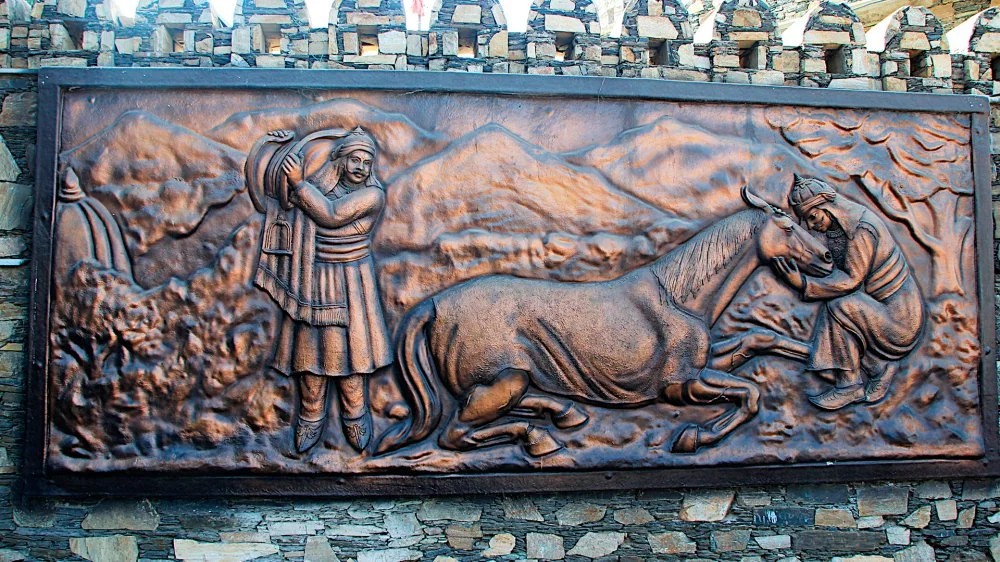Конные памятники знаменитых полководцев и правителей отнюдь не редкость. Однако меварскийi
Согласно преданиям, конь Четак принадлежал одному из национальных героев Индии, правителю раджпутского княжества Мевар Махаране Пратапу (1540-1597). Махарана Пратап -- правитель, в биографии которого тесно переплетены исторические реалии и полулегендарные сюжеты. Подобно своему отцу, а впоследствии и сыну, он в первую очередь выступает как борец с экспансией Империи Великих Моголов. Пик этой борьбы приходится как раз на правление Махараны Пратапа.
Историческая традиция не сообщает, как звали княжеского коня, и не приписывает ему боевые подвиги, однако в местном фольклоре он обретает имя и подробную биографию. Считается, что самое известное описание истории Четака составил офицер Британской Ост-Индской торговой компании по имени Джеймс Тод (1772-1835), который, в свою очередь, опирался на более древние сказания и песни. Англичанин интересовался историей региона, в котором служил, и даже стал впоследствии автором фундаментальной работы “Анналы и древности Раджастана, или Центральные и западные штаты Раджпутана в Индии”.

Мемориальная доска с изображением Махараны Пратапа/Shutterstock
Описывая правление Махараны Пратапа, Тод свидетельствует, что жеребец был подарен правителю торговцами из Катхиавара, региона, который славился своей собственной породой лошадей. Рассказывается также, что Махарана сознательно выбрал себе именно Четака, испытав коня на скорость и реакцию.
В этом варианте сюжета жеребца несколько раз называют синей лошадью, что, по-видимому связано с его боевым облачением. По аналогии с этим и самого Махарану Пратапа в некоторый текстах называют синим всадником.
Самый известный сюжет, связанный с Четаком, относится к 1576 году, когда его хозяин возглавлял войско княжества Мевар в битве при Халдигхати. На тот момент государство Махараны Пратапа оставалось последней территорией Раджастхана, которая было неподконтрольно могольскому императору. Историческая и фольклорная традиции сходятся на том, что численное преимущество было на стороне моголов, однако в народных легендах размер войска последних явно преувеличен.
Несмотря на это, источники описывают события того дня как упорное сражение, инициатива в котором неоднократно переходила от одной стороны к другой. Считается, что одним из решающих факторов победы моголов в итоге стало ранение и последующее бегство с поля битвы предводителя раджпутов. Именно вокруг этого бегства и построен сюжет с конем Четаком.
В песне Кхуманно-Расо, легшей в основу пересказа Джеймса Тода, говорится, что в кульминационный момент битвы Махарана Пратап сошёлся в неравном поединке с предводителем могольского войска Маном Сингхом. Тот сражался на боевом слоне. Легенда гласит, что Четак поднял копыта и ударил им слона в голову, выиграв для своего хозяина драгоценное время. Бивень слона пронзил ногу коню, однако Четак выстоял и даже вынес своего раненого хозяина с поля боя.

Скульптура Четака/Alamy
Хотя битва была формально проиграна, лидер раджпутов выжил и впоследствии продолжил сопротивление могольской экспансии. Поэтому неудивительно, что Махарана Пратап решил увековечить образ своего спасителя в памятнике в городе Раджсаманд. Эта статуя стала лишь первой в целой череде подобных, а образ Четака навсегда закрепился в фольклоре Северной Индии.
Примечательно, что в дальнейшем битва при Халдигхати неоднократно переосмыслялась индийскими националистами. В более поздней традиции её трактовали как боевую ничью или даже победу Махараны Пратапа, который со временем превратился в одного из главных символов национально-освободительного движения в колониальную и постколониальную эпоху.
Ожидаемо, вслед за своим хозяином новую жизнь обрёл и образ коня Четака. В наши дни в Индии существует несколько мемориальных комплексов, посвященных как самому коню, так и битве, в которой он совершил свой подвиг. Существует и место, где, как считается, погиб Четак. Сегодня имя коня носит и производимая в Индии по лицензии версия французского вертолёта Alouette III и поезд-экспресс.

Статуя Махараны Пратапа/Wikimedia Commons
ЧТО ПОЧИТАТЬ
1. Успенская Е. Раджпуты. Рыцари Средневековой Индии. - Спб.: 2000. Евразия.
2. Вигасин А. История и культура Древнего Востока: энциклопедический словарь. - М.: 2008, РОССПЭН.
3. Tod J. Annals and Antiquities of Rajasthan. - London: 1832, Smith, Elder.
